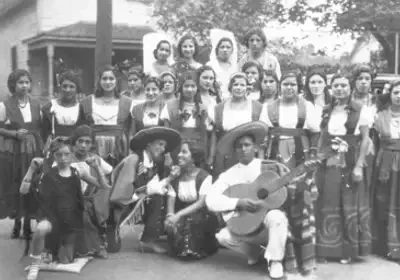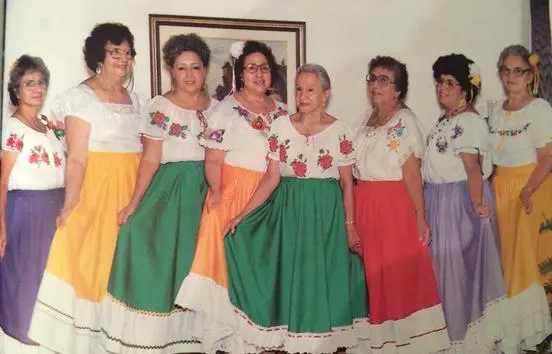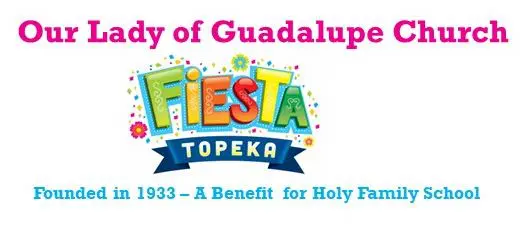History of Our Lady of Guadalupe Fiesta Mexicana

Members of the Bells of 1933 gathered in costume following the First Annual Fiesta Mexicana parade: 1st Row: Nina Valadez, Lisa Valadez, Josefine Gomez Moreno, Victoria Lerma Morales, Antanacio Corona
2nd Row: Lalita Valadez, Enriqueta Martinez Flowers, Socorro Llamas Ramirez, Felipa Del Hierro Granado, Nettie Del Hierro Serna, Antonia Mosqueda, Jennie Cornejpo, Hermelenda Vargas, Teresa Cruz, Jovita Cruz
3rd Row: Mary Vargas, Piedad Cornejo, Alex Gomez Alcala, Agnes Vargas, Romana P. Balandran, Carmen Gomez Perez, Sabina Martinez Terry; 4th Row: Augustina Lopez Gomez, Tillie Martinez Gonzalez, Mary Lopez Oliva and Josefine Llamas
Not pictured: Grace Renteria Charay, Natalia Renteria, Nate Morales

Members of the Bells of 1933 gathered in costume following the 55th Annual Fiesta Mexicana.
Some of the members whose names are known starting fourth from the left are: Hazel Gomez, Victoria Lerma Morales, Molly Corona, and Guadalupe "Lupe" Perez
The first Fiesta Mexicana was a one day event held on August 17, 1933, on the grounds of our Lady of Guadalupe Church. It was organized by Father Augustine Cuartero and the parishioners, with the special assistance of Mrs. Genevieve McDade, a local philanthropist from Assumption Parish who was very active in helping the Mexican community and Our Lady of Guadalupe Church, during the depression years.
Initial Fiestas were small events, held tightly within Topeka’s Mexican barrio. Parishioners and extended family were the only attendees and food items were cooked from the home and brought to the church grounds to sell. Entertainment was local with the emphasis on music and dances from the homeland of Mexico. Ask a longtime parishoner what “memorias” come to mind from past Fiestas, and the answers would be as colorful as the event itself. Children relishing the many flavors of raspas (snow cones). Youth mischievously cracking cascarones (confetti eggs) over a friend’s head. The sound of gritos (Spanish for a long shout of happiness) to ranchero or corrido music played. All the sites and sounds recalled on those warm summer nights…
As part of that first Fiesta, traditional Mexican dances and songs were performed by a group of about twenty-eight dancers, singers, and musicians. Mrs. H.T. Legerwood, assisted Mrs. McDade by coordinating the dances for the Fiesta. It wasn't long before the Fiesta programs, under the management of Mrs. McDade, reported attendance by the thousands. From the 1930's to now, we maintain this valuable cultural tradition. Many parishioners such as Lupe Perez, Victoria Morales, Marti Martinez, Delia Ramirez, Margaret Villegas, Ediberto Gonzales, Arnold and Sandra Villegas and more have volunteered and developed the dance troupes such as Aguilas Aztecas, Bailes Mestizos and Ballet Folklorico De Topeka and Our Lady of Guadalupe Dancers. The Fiesta also incorporates dancers from outside of our community such Lawrence and Kansas City.
Then, as now, all of the food for the Fiesta was prepared by the parishioners. The first Fiesta lasted for only one day, but it was so financially successful that people requested that it be held again the next year. A second successful Fiesta was held in 1934 and that led to a decision to make the Fiesta an annual event. Over the years, the Fiesta has been extended so that it now lasts for five days, has gone from a quarter of a block to several blocks surrounding the parish neighborhood and includes a Queen and King contest, a coronation dance, an annual parade down Kansas Avenue, a golf tournament, and a 5K run/walk in the Oakland area.
The Fiesta has also grown larger and larger to the point that it is today. Our Lady of Guadalupe’s Fiesta Mexicana is one of the oldest community Hispanic celebrations in the United States. From a historical and cultural perspective, the Fiesta has been and still is extremely important to the Mexican community in Topeka, Kansas. It is important because it teaches young Mexican-Americans about their Mexican culture and allows older Mexicans to stay connected to their culture and history. Current planning for each Fiesta follows closely on the heels of the one just concluded. It is not unusual for Fiesta volunteers to plan their vacations to be taken during this “big week” or for former Topekans to re-visit Kansas solely to attend our annual event.
The initial vision of Father Augustin Cuartero, encompassed not only the sharing of our Mexican culture, but its primary purpose, which remains unchanged, is to support the parish's school and education of the children. In 1921, a modest school was built and by 1953, funds from Fiestas were used to build a more expansive school to house increasing student enrollment. That school still stands today and continues to be used for the education of our children and parish ministries.
Fiesta time is a link that connects our past to our future.
Countless changes have occurred since the Fiesta of 1933 - from adding a professional carnival, welcoming all types of vendors, partnering with area businesses and bringing in the highest level of Latin entertainment. We have stages of rich entertainment, more variety, more food and definitely more fun! While culture and tradition have continued to be the backbone of Fiestas, we have opened our arms to the wider community, state and country by seeking creative ways to highlight our longevity and showcase our changing pace.
We feel strongly about what our Fiesta (past and present) has to offer. As you browse through our website, we hope it entices you to come visit…it is well worth it!
